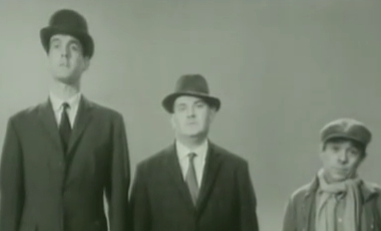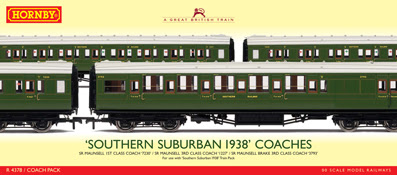Correspondent Peter reminds fbb that the roots of Southern's problems (see yesterday's blog) were sealed into the terms and conditions of the mega franchise that was awarded to GoAhead (strictly GoVia). Driver Only Operation, ticket office closures etc. etc. were built in to the terms of the deal. So, financially, the company has no choice - it has to be delivered.
So from day one the Unions we ready for a long fight.
The RTMnews web site ...
... thus reported, back in 2014.
Back to Our Enigmatic Headline
John Cleese, tall and patrician in appearance and demeanour, represents the upper class; Ronnie Barker, of average height, the middle class, and Ronnie Corbett, short in stature, the working class. Each in turn describes their social advantages and disadvantages, and contrasts them with their neighbours, an effect emphasised by the actors' relative heights as they look downwards or upwards to each other:
Barker: "I look up to him [Cleese] because he is upper class, but I look down on him [Corbett] because he is lower class."
Corbett: "I know my place."
So, historically (in the 19th century), the railways of Britain had three classes bnoradly designed to cater for the three "social" strata of society.
2nd class largely disappeared as 19th became 20th century - leaving a typical UK anomaly of trains offering First and Third class but not Second. There was a "good" reason for this silliness; the Law required all train companies to offer First and Third class on ALL trains with no obligation to provide Second.
Third was renamed Second in 1956 and renamed again as Standard in the early 80s.
But to cope with the legal requirements and to ensure that the superior class was always available to bring in loadsamoney, the railways needed to be very clever with their coach design. For lightly used services they cam up with the composite coach.
This vehicle (at the Keighley and Worth Valley Railway) shows one solution. The first class compartments (labelled "1") had their own corridor leasding to their exclusive toilet in the centre of the carriage. The snivelling third class "lower orders" had a corridor on the other side leading to their toilet 0 and ne'er the twain would meet! Note that there was no connection between coaches; this version was NON-gangwayed.
Third was renamed Second in 1956 and renamed again as Standard in the early 80s.
But to cope with the legal requirements and to ensure that the superior class was always available to bring in loadsamoney, the railways needed to be very clever with their coach design. For lightly used services they cam up with the composite coach.
This vehicle (at the Keighley and Worth Valley Railway) shows one solution. The first class compartments (labelled "1") had their own corridor leasding to their exclusive toilet in the centre of the carriage. The snivelling third class "lower orders" had a corridor on the other side leading to their toilet 0 and ne'er the twain would meet! Note that there was no connection between coaches; this version was NON-gangwayed.
Carriages with both classes were called "composite". Later versions were even more multi-purpose. They included a guards compartment complete with emergency brake controls.
Guess what? These were called "brake composite".
And fbb bought one.
This preserved version does not have a "1" added for the first class bit, but careful observation reveals that the two windows nearest the guards van (brake) are spaced further apart; a few extra inches of leg room for hose wealthy enough to pay the premium.
But fbb has not bought a real full-sized carriage, merely an 00 gauge model. It looked like this:-
It was, as you would expect with fbb, pre-owned and cheap (£10). It was green with a white roof and was, indeed, a brake composite vehicle. The three compartments (left-ish) next to the guard's van have slightly wider pillars between the sets of windows and door. If your eyesight is good, you might be able to read the word "first" on those three doors.
But what was it? Who made it and when?
The inside of the coach walls carried the number R428 and the chassis had a small "Triang" imprint. And here, ta da!, is R428.
Not all fbb's readers are interested in the model scene, but even the most bored will spot that the carriage is not green. The shape looks similar but green it definitely isn't. In 1963 Triang introduced a very fine model (for its day) of the celebrate "Caley Single"; i.e. a loco with a single driviing wheel (well, one each side!) built for and operated by The Caledonian Railway.
Here is the real thing.
Caledonian Railway Single No. 123 is a preserved Scottish steam locomotive. The unique 4-2-2 was built by Neilson and Company in 1886, works No. 3553, as an exhibition locomotive. In 1914 it was placed on the Caledonian Railway duplicate list, and renumbered 1123. It entered London, Midland and Scottish Railway service in 1923 and the LMS renumbered her 14010 and gave her the power classification 1P. During the 1920s it was allocated to working the directors' saloon, but it was returned to ordinary service in 1930. The locomotive was withdrawn in 1935, by which time it was the last single-wheeled express engine running in Britain, and set aside for preservation.
Guess what? These were called "brake composite".
And fbb bought one.
This preserved version does not have a "1" added for the first class bit, but careful observation reveals that the two windows nearest the guards van (brake) are spaced further apart; a few extra inches of leg room for hose wealthy enough to pay the premium.
But fbb has not bought a real full-sized carriage, merely an 00 gauge model. It looked like this:-
But what was it? Who made it and when?
The inside of the coach walls carried the number R428 and the chassis had a small "Triang" imprint. And here, ta da!, is R428.
Here is the real thing.
Caledonian Railway Single No. 123 is a preserved Scottish steam locomotive. The unique 4-2-2 was built by Neilson and Company in 1886, works No. 3553, as an exhibition locomotive. In 1914 it was placed on the Caledonian Railway duplicate list, and renumbered 1123. It entered London, Midland and Scottish Railway service in 1923 and the LMS renumbered her 14010 and gave her the power classification 1P. During the 1920s it was allocated to working the directors' saloon, but it was returned to ordinary service in 1930. The locomotive was withdrawn in 1935, by which time it was the last single-wheeled express engine running in Britain, and set aside for preservation.
And here is the model as sold in a set with R427 and R428 coaches.
But the R428 coach still isn't green!
Thanks to the wonders of the interwebnet and some diligent keyboard prodding, fbb was able to resolve the problem. Those cunning people at Margate (former HQ of Triang) had used the moulds of an R428 and filled them with green plastic goo to produced a "Southern Suburban 1938 coach" ...
... and they renumbered as R479 in the catalogue. Here it is:-
It was only produced from 1971 to 1973, so fbb's model is at least 46 years old. Seen here peeking out from Peterville tunnel with its companion "Terrier" named and numbered as an Isle of Wight engine ...
... it is obvious that the quoted colour of the carriage, viz "olive green", is not right. Southern's "olive" was quite a dark and rich colour seen here on a preserved coach at the Bluebell Railway.
The "cheap and cheerful" coach that fbb has bought is probably not an accurate model of anything that the Southern Railway ever ran. The green plastic looks wrong, the white roof looks wrong and the model is empty, devoid of compartments and seats. Modern models are much more fully detailed, almost always models of a specific vehicle and ...
... frighteningly expensive.
So perhaps fbb could "fettle up" his 43 year old model to make it look a bit better. Maybe - but that is another story and another blog.
The "cheap and cheerful" coach that fbb has bought is probably not an accurate model of anything that the Southern Railway ever ran. The green plastic looks wrong, the white roof looks wrong and the model is empty, devoid of compartments and seats. Modern models are much more fully detailed, almost always models of a specific vehicle and ...
... frighteningly expensive.
Hornby Maunsell brake composite, £38. OUCH.
So perhaps fbb could "fettle up" his 43 year old model to make it look a bit better. Maybe - but that is another story and another blog.
Next Sheffield bus blog : Monday 27th June

















While the initial stimulus to get rid of 2nd class dates back to the Midland Railway doing so back in around 1880, 2nd class did linger on the Continental boat trains until the 1950s, to correspond with three classes on the far side of the Channel. The Southern Railway had some "£unclassified" carriages which could be used for this. It was only after this anomaly was finished that "3rd" could become "2nd" all round.
ReplyDeleteOn a similar vein, I'm sure that I went to Whitby Station many years ago and found that the single platform remaining at that time was "Platform 2"!
And, of course, we also have several platform 0s. And a 9 3/4
DeleteActually, the "Southern Suburban 1938 coach" is a reasonably accurate representation of main line Maunsell stock - the same as illustrated at the bottom of the post. And as the logo on the box reveals, rather more recent than 1973.
ReplyDeleteThe dark green and white combination was also applied to Mark 1 stock, at the time that Triang/Hornby was issuing locos such as the L1 and M7 in Southern Railway colours.
Your coach is model R750 - there was an accompanying R749 composite. All nicely illustrated here http://toyandtrainspotter.weebly.com/triang-hornby-sr-coaches.html
I can't recall what the model was actually based on, but as was often the case at this time, it was less than accurate. The prototype was almost certainly only 57 feet long, whereas this model used the standard Triang Mark 1 underframe and ends, based on a 63 feet design.
Thanks "Man". On reflection, the box of "1938" coaches might well be the later Maunsells priced at £38. My model is definitely the older former Caledonian moulding.
ReplyDelete